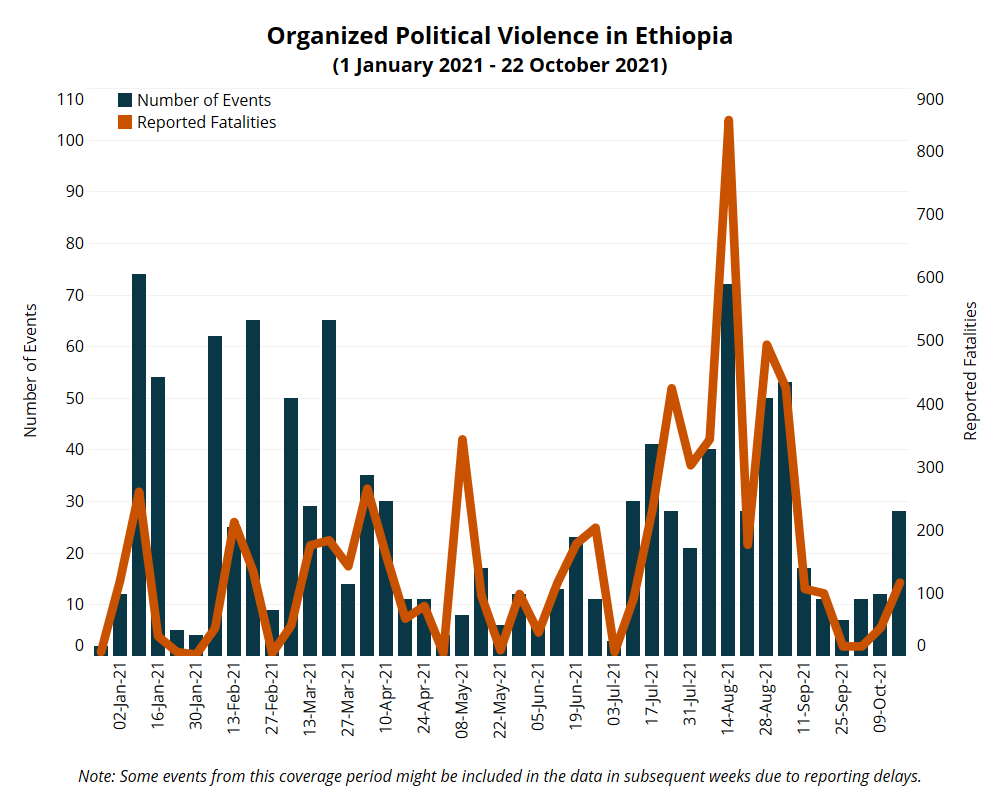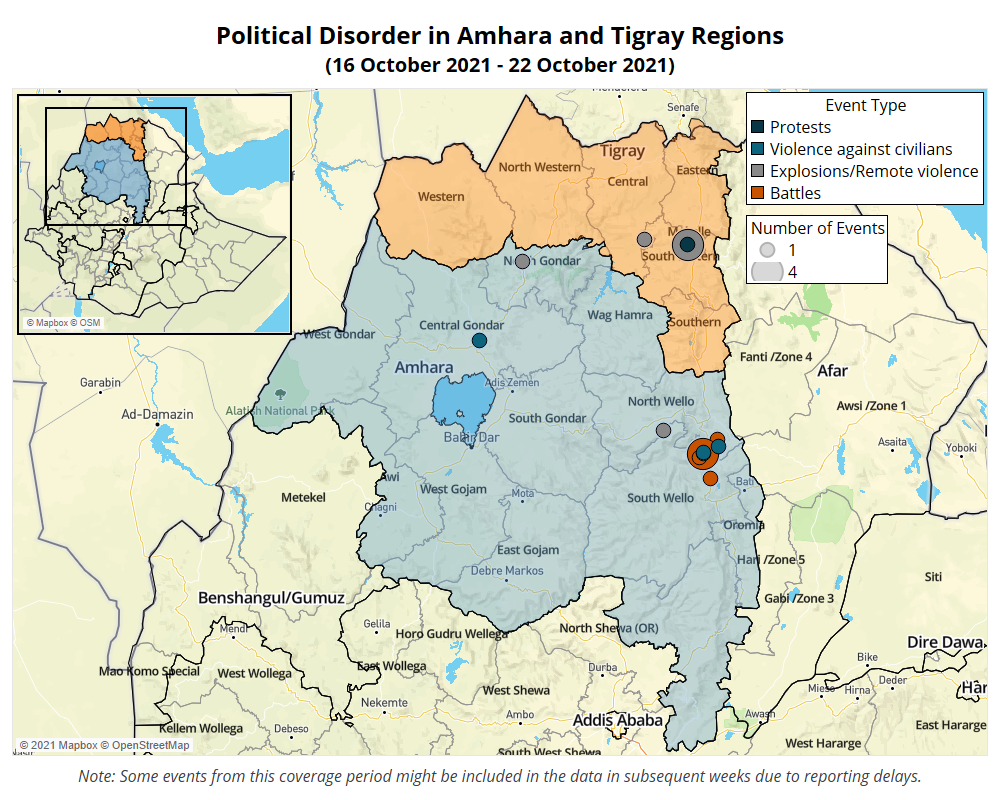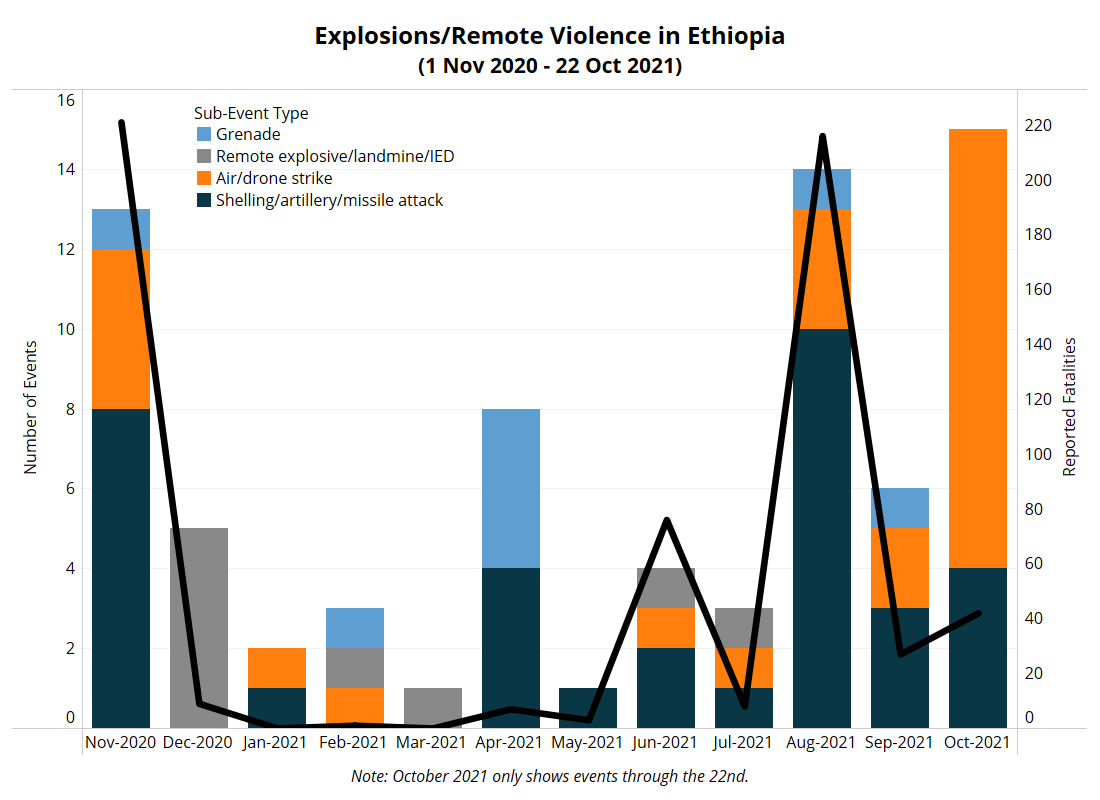By the Numbers: Ethiopia, 2 April 2018-22 October 20211Figures reflect violent events reported since Prime Minister Abiy Ahmed came to power on 2 April 2018
- Total number of organized violence events: 2,091
- Total number of reported fatalities from organized violence: 12,303
- Total number of reported fatalities from civilian targeting: 5,711
By the Numbers: Ethiopia, 16-22 October 20212Some events from this coverage period might be included in the data in subsequent weeks due to reporting delays.
- Total number of organized violence events: 28
- Total number of reported fatalities from organized violence: 117
- Total number of reported fatalities from civilian targeting: 79
Ethiopia data are available through a curated EPO data file as well as the main ACLED export tool.

Situation Summary
Last week, Ethiopian National Defense Force (ENDF) airstrikes resumed in the Tigray region. From 18 October 2021 to 22 October 2021, the ENDF conducted five airstrikes in the Tigray region. The airstrikes mark the first round of such attacks by the government since it announced a unilateral ceasefire in June 2021.
Meanwhile, in the Amhara region, TPLF forces and the ENDF, alongside Amhara regional special forces and Amhara militias, clashed in different areas in the North and South Wello zones (see map below). On 17 October 2021, TPLF shelled an ancient mosque in Zarima town in the North Gondar zone. Around 18 October 2021, TPLF forces shelled Ambassel town in the North Wello zone, killing an unspecified number of people. Moreover, witnesses stated that TPLF forces killed 13 civilians in Wirgesa in Habru woreda in North Wello (Amhara Media Corporation, 20 October 2021). TPLF reportedly poured gasoline on the individuals and set them on fire before shooting and killing them (Amhara Media Corporation, 20 October 2021; Ethiopian Press Agency, 20 October 2021).

The Amhara regional government has called for mass mobilization throughout the region and encouraged individuals to travel to both North and South Wello zones to defend the area from further TPLF attacks (Amhara Media Corporation, 21 October 2021). At the beginning of the week, authorities from the South Wello zone administration made a similar call to the public (Amhara Media Corporation, 18 October 2021).
In the Afar region, clashes have resumed after a lull in September. Armed clashes between TPLF and ENDF, accompanied by Afar regional special forces, were reported last week in the Chifra area which borders the Amhara region.
Civilians continue to suffer due to armed clashes. In the Amhara region, around 250 people were displaced due to the fighting in Girana town last week, while TPLF fighters reportedly killed an unspecified number of civilians as they fled Habru woreda in the North Wello zone (Reuters, 23 October 2021). Furthermore, TPLF forces are allegedly harvesting farmlands within the Amhara region and taking the harvest to the Tigray region. Hence, the number of people in need of humanitarian assistance is expected to increase in the coming months. Similarly, due to the recent clashes in Afar, around 45,000 people have been internally displaced from Chifra and Megale woredas (BBC Amharic, 20 October 2021).
In the Oromia region, armed clashes continued between the government forces and the Oromo Liberation Front (OLF)-Shane. On 16 October 2021, OLF-Shane militants reportedly attacked military patrol vehicles in Adda Berga woreda, West Shewa zone. On 17 October 2021, ENDF units clashed with OLF-Shane militants in Boba kebele of Gumi Idalo woreda in East Guji. The next day, the two groups clashed in Siree Buki and Utullu kebeles of Saba Boru woreda in the Guji zone. Furthermore, OLF-Shane militants continued to attack civilians in the Oromia region. Last week, on 18 and 19 October 2021, OLF-Shane members were accused of attacking civilians in the Merkato area in Beko-Jimma kebele in Sibu Sire woreda in the East Wollega zone.
Also last week, on 18 October 2021, Oromo and Amhara ethnic militias clashed in Amuru town in the Horo Guduru Wollega zone. In the past few weeks, several clashes between Oromo and Amhara ethnic militias have been reported in areas of contested territory within the Oromia region (EHRC Press Release, 18 October 2021). Clashes between Oromo and Amhara communities have occurred periodically in these areas. However, more recently, these clashes have worsened in the context of decreased state security capacity due to the demand for additional troops in northern Ethiopia. Many reports from the area indicate that militias related to OLF-Shane are involved in the targeting of Amhara civilians in the area, a claim the group denies.
In Benshangul/Gumuz region, on 19 October 2021, unidentified gunmen shot and killed two civilians in Dibate city in the Metekel zone. On the same day, unidentified gunmen shot and killed two civilians in Galesa kebele in Dibate Woreda in the Metekel zone (DW Amharic, 20 October 2021). Some accused security forces of the attack in Galesa kebele. However, the allegation was denied by the head of the command post stationed in the area who blames armed groups active in the area for these attacks.
Weekly Focus: Airstrikes in Northern Ethiopia
As battles rage between TPLF forces and ENDF and government-aligned forces, the Ethiopian military has begun an airstrike campaign against TPLF targets across the Tigray region as the rainy season comes to an end. Airstrikes against TPLF targets have been reported throughout the conflict. However, this is the first time since the beginning of the conflict in November 2020 that Ethiopian air force jets have struck TPLF targets in Mekelle city, the capital of the Tigray region. Airstrikes in Mekelle had last been recorded on 19 November 2020. Mekelle’s population has swelled as a result of displacement in rural towns throughout the war, placing a high number of people at risk in the case of errant strikes.
Remote violence, including airstrikes, has been an increasingly common feature of the Ethiopian war since August of 2021 when the TPLF’s advance southward through the Amhara region began to slow (see figure below). Other forms of remote violence used during the conflict include shelling using heavy weapons, especially by the TPLF. Recent artillery barrages against the towns of Wuchale (South Wello) and Chifra (located on the Afar/Amhara regional border) reportedly led to the death of 30 people. A recent statement by the TPLF that Dessie city was within artillery range of their forces sparked panic in the city and the price of transportation in North and South Wello zones skyrocketed as civilians attempted to flee (Ethiopian Insider, 21 October 2021). Infrastructure throughout Tigray, Afar, and Amhara regions has been damaged as a result of an increasing reliance on remote violence.

In comparison to the heavy shelling incidents reported throughout the war, the use of airstrikes by the Ethiopian government is a new trend. On 22 October 2021, Ethiopian jets conducted an airstrike on Mekelle as a scheduled UN flight carrying humanitarian workers was inbound, forcing the UN flight to abort the landing (Reuters, 23 October 2021). The UN has since suspended all flights to Tigray, citing concerns of risk to aircraft from indiscriminate fire (Relief Web, 6 October 2021).
TPLF officials have accused the Ethiopian military of using the UN flight as cover from anti-aircraft fire, a claim that may have some credibility given that the UN flight was scheduled with Addis Ababa authorities before departure. Ethiopian government officials have claimed that tower operators in Mekelle forced the flight crew to abandon landing and insisted that the strike was carried out with “extreme caution” (The Ethiopian Ministry of Foreign Affairs, 23 October 2021).
Both the TPLF’s recent advances southward and the government’s use of airstrikes against TPLF targets indicate that the war in Ethiopia is intensifying. Both sides seem unconcerned about the threat of sanctions. The government’s willingness to schedule an airstrike within a similar time frame as a scheduled humanitarian flight illustrates an ever-worsening relationship between the UN and the Ethiopian federal authorities. Both the ENDF and TPLF seem likely to continue to use remote violence going forward. This threatens both civilians and civil infrastructure as neither the TPLF nor the Ethiopian government have a good record of accuracy (Reuters, 19 October 2021; France 24, 26 August 2021).
Election Update
Last week, the National Electoral Board of Ethiopia (NEBE) released a new election timeline for the delayed June general election in Benshangul/Gumuz region. Elections in Metekel and Kamashi zones were delayed due to security concerns. According to the new timeline, the sixth general election will be held on 30 December 2021 in 17 election constituencies in Benshangul/Gumuz region (NEBE, 19 October 2021). In addition, NEBE plans to establish polling stations within Benshangul/Gumuz region for internally displaced people from Metekel and Kamashi zones (NEBE, 19 October 2021). Benshangul/Gumuz region is the only region that did not establish a new government because elections were not held for the majority of the regional council seats. During the June 2021 election, elections were held for only 34 seats out of the 99 regional council seats.






